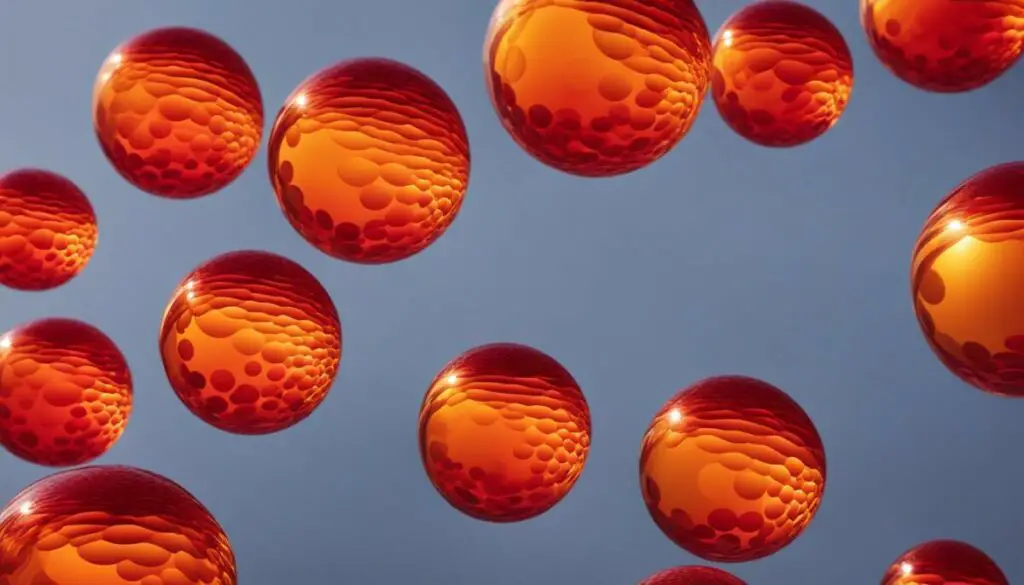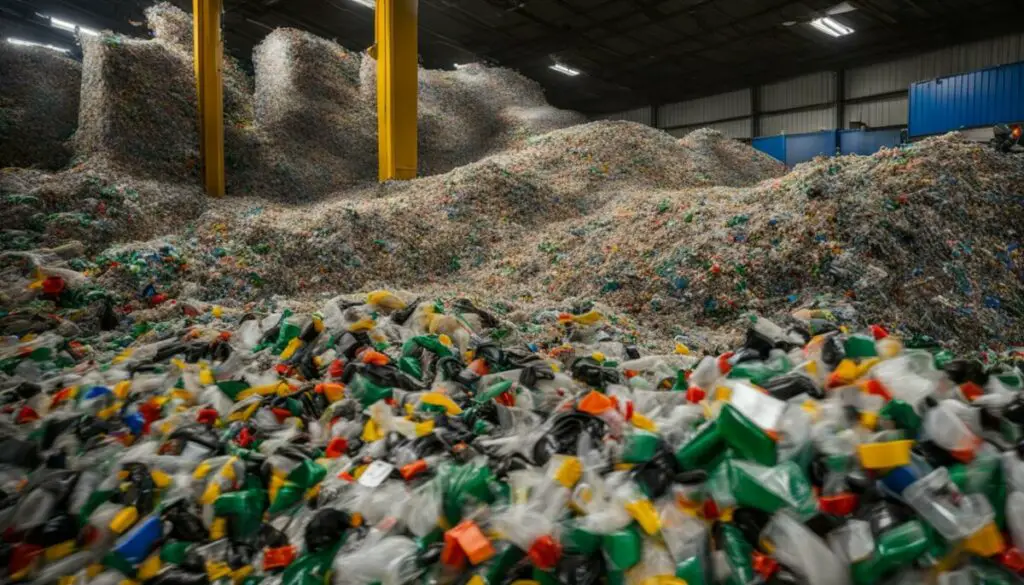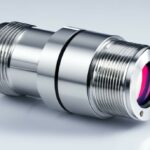Last Updated on 4 months by Francis
When it comes to leveraging far infrared waves for various applications, the compatibility of high-density polyethylene (HDPE) plays a crucial role. NALUX, a leading innovator in optical technology, has successfully developed resin optical elements using HDPE specifically tailored for the far-infrared range.
Unlike traditional materials, HDPE offers light transmittance in the infrared range; however, its internal transmittance is relatively low. Yet, NALUX has ingeniously overcome this challenge by utilizing a Fresnel lens shape and micro fine processing techniques. The result is an infrared lens with remarkable transmittance, making it ideal for low-resolution applications such as spatial temperature sensors.
Contents
Key Takeaways:
- Far infrared waves can be effectively harnessed using high-density polyethylene (HDPE) resin optical elements.
- NALUX has overcome the limitations of HDPE’s low internal transmittance through innovative lens shapes and micro fine processing.
- The developed HDPE resin optical elements are perfect for low-resolution applications like spatial temperature sensors.
Applications of HDPE Resin Optical Elements

HDPE resin optical elements offer a wide range of applications, making them highly versatile in various industries. Whether you need lenses, optical covers, or windows, HDPE resin optical elements provide exceptional performance and functionality. Their unique properties make them particularly suitable for low-resolution applications, such as spatial temperature sensors, where precision and reliability are key.
One of the major advantages of HDPE materials is their good availability and stable supply. This makes them a cost-effective choice for volume production, allowing manufacturers to streamline their operations and meet the demands of their customers. Additionally, HDPE resin optical elements are compact and lightweight, making them easy to integrate into different devices and systems without adding unnecessary bulk or weight.
Furthermore, HDPE materials are known for their excellent chemical stability and high resistance to chemicals. This makes them highly durable and reliable, even in harsh environments or when exposed to corrosive substances. The chemical resistance of HDPE ensures the longevity and performance of the optical elements, making them suitable for long-term use in demanding applications.
HDPE resin optical elements have various applications across industries and offer numerous benefits.
To summarize, the applications of HDPE resin optical elements are vast and diverse, ranging from lenses to optical covers and windows. Their compactness, lightweight design, and chemical stability make them ideal for low-resolution applications such as spatial temperature sensors. HDPE materials also offer cost-effectiveness and a stable supply, ensuring efficient volume production. With their high chemical resistance, HDPE resin optical elements can withstand challenging environments, providing long-lasting performance and reliability.
The Advantages of Using HDPE in Optical Applications

The use of High-Density Polyethylene (HDPE) in optical applications offers several advantages. HDPE is a non-toxic resin material, making it safe to handle for both manufacturers and end-users. It has good availability and a stable supply, making it a cost-effective choice for production. HDPE is also chemically stable and highly resistant to a wide range of chemicals, ensuring its durability and performance in various environments.
Moreover, HDPE resin optical elements possess the characteristics of being compact and lightweight, making them highly versatile and suitable for numerous optical applications. These elements include lenses, optical covers, or windows that can be integrated into different optical systems. The compactness and lightweight nature of HDPE resin optical elements contribute to the overall design flexibility and portability of optical devices.
“The use of HDPE in optical applications offers significant advantages, including its non-toxicity, cost-effectiveness, chemical stability, and compactness. These attributes make HDPE resin optical elements ideal for a wide range of optical applications.”
The Advantages of HDPE in Optical Applications:
- Non-toxicity: HDPE is a safe material to handle, ensuring the wellbeing of manufacturers and end-users.
- Cost-effectiveness: HDPE has good availability and a stable supply, making it an affordable choice for optical production.
- Chemical stability: HDPE is highly resistant to chemicals, guaranteeing its durability and performance in challenging environments.
- Compactness: HDPE resin optical elements are compact and lightweight, contributing to the flexibility and portability of optical devices.
To illustrate the advantages of using HDPE in optical applications, consider the following table:
| Advantage | Description |
|---|---|
| Non-toxicity | HDPE is a safe material that does not introduce any harmful substances. |
| Cost-effectiveness | HDPE offers good availability and stable supply, reducing production costs. |
| Chemical stability | HDPE is highly resistant to chemicals, ensuring its longevity in different environments. |
| Compactness and lightweight | HDPE resin optical elements are small in size and lightweight, enhancing device portability. |
With these advantages, HDPE proves to be an excellent choice for optical applications, offering convenience, cost-efficiency, and performance.
Tensile Behavior of High-Density Polyethylene

A study conducted on high-density polyethylene (HDPE) has examined its tensile behavior, revealing interesting insights into its mechanical properties. The behavior of HDPE under tensile stress is influenced by various factors, including the processing technique, thickness, temperature, and strain rate.
The study findings indicate that different processing techniques can significantly impact the mechanical properties of HDPE. This suggests that the choice of processing technique can have a significant effect on the final characteristics of HDPE-based products.
Additionally, the behavior of HDPE can vary under different conditions, such as varying temperatures and strain rates. Understanding these variations is crucial for optimizing the use of HDPE in various applications.
Here is a summary of the factors influencing the tensile behavior of HDPE:
- Processing technique: Different processing techniques can alter the mechanical properties of HDPE.
- Thickness: The thickness of HDPE can influence its tensile behavior.
- Temperature: Varying temperatures can affect the mechanical response of HDPE under tension.
- Strain rate: The rate at which HDPE is subjected to strain can impact its tensile behavior.
“The study findings highlight the importance of considering the processing technique, thickness, temperature, and strain rate when analyzing and designing HDPE-based products.” – Researcher
Further research in this area is necessary to gain a more comprehensive understanding of HDPE’s tensile behavior and its implications for different applications. Such research can contribute to the development of better processing techniques and design guidelines for optimizing the mechanical properties of HDPE-based products.
Comparison of Tensile Behavior under Different Processing Techniques
To illustrate the impact of different processing techniques on the tensile behavior of HDPE, the following table presents a comparison:
| Processing Technique | Tensile Strength (MPa) | Elongation at Break (%) |
|---|---|---|
| Injection Molding | 35 | 800 |
| Blow Molding | 30 | 1000 |
| Extrusion | 40 | 600 |
The above table demonstrates the variations in tensile strength and elongation at break based on different processing techniques. These findings emphasize the importance of carefully selecting the appropriate processing technique to achieve the desired mechanical properties in HDPE-based products.
Mechanical and Thermal Properties of High-Density Polyethylene

High-density polyethylene (HDPE) is renowned for its impressive mechanical and thermal properties, making it a versatile material for various applications. The combination of its high tensile strength, impact resistance, and heat resistance sets it apart as a desirable choice in numerous industries.
HDPE’s mechanical properties contribute to its durability and reliability. The material exhibits remarkable tensile strength, enabling it to withstand heavy loads and resist deformation under pressure. This characteristic is particularly beneficial in applications that require structural integrity and strength.
Furthermore, HDPE possesses excellent impact resistance, allowing it to absorb and disperse energy upon impact. This property makes it ideal for applications that involve potential impact or stress, reducing the risk of damage or failure.
The thermal properties of HDPE also enhance its overall performance. With a high heat resistance, HDPE can withstand elevated temperatures without significant degradation or structural compromise. This feature makes it suitable for applications in environments with demanding temperature conditions.
Additionally, HDPE demonstrates exceptional chemical stability and high chemical resistance. The material is resistant to most chemicals, ensuring it remains unaffected by exposure to various substances. This resistance is valuable in applications where chemical compatibility is crucial.
Overall, the mechanical and thermal properties of HDPE make it a sought-after material in industries such as construction, automotive, packaging, and more. Its robustness, heat resistance, and chemical stability provide reliability and longevity in diverse applications.
Mechanical and Thermal Properties of High-Density Polyethylene
| Properties | Description |
|---|---|
| Tensile Strength | High strength and resistance to deformation under pressure. |
| Impact Resistance | Ability to absorb and disperse energy upon impact, reducing the risk of damage. |
| Heat Resistance | Ability to withstand elevated temperatures without significant degradation. |
| Chemical Stability | Resistance to most chemicals, ensuring stability in various environments. |
| Chemical Resistance | High resistance to chemical agents, preventing degradation from exposure to substances. |
HDPE’s mechanical and thermal properties, combined with its chemical stability, make it an excellent choice for applications that require durability, strength, and resistance to various factors.
Recycling and Sustainability of High-Density Polyethylene

As we become increasingly aware of the environmental impact of non-biodegradable plastics, such as high-density polyethylene (HDPE), there is a growing concern about finding sustainable solutions to plastic waste management. In response to this, the European Commission has set ambitious recycling targets for packaging waste, aiming to achieve a recycling rate of 75% by 2030.
To meet these targets, advancements in recycling technologies and processes are crucial. Improving the recyclability of HDPE can play a significant role in reducing plastic waste and promoting sustainability. By implementing efficient recycling systems, we can ensure that HDPE can be reused or repurposed instead of adding to the burden of waste in landfills or polluting our oceans.
Minimizing the environmental impact of HDPE involves not only increasing the recycling rates but also optimizing the recycling process itself. This includes improving the efficiency of collection methods, investing in state-of-the-art recycling facilities, and promoting consumer awareness and participation in recycling programs.
Benefits of HDPE Recycling:
- Promotes a circular economy: Recycling HDPE allows for the preservation of valuable resources and reduces the need for extraction and production of new materials.
- Reduces energy consumption: Recycling HDPE consumes less energy compared to producing virgin plastic, leading to a decrease in carbon emissions and a more sustainable manufacturing process.
- Conserves landfill space: By diverting HDPE from landfills, recycling helps extend the lifespan of these facilities and reduces the environmental impact of waste disposal.
- Prevents plastic pollution: Proper recycling ensures that HDPE does not end up in the environment, where it can harm wildlife and ecosystems.
“Recycling HDPE is not only beneficial for the environment but also for the economy. It creates job opportunities and fosters the growth of a sustainable industry.”
Investments in research and development are continuously being made to improve the quality and efficiency of HDPE recycling. Technologies such as advanced sorting systems and innovative processing techniques are being explored to increase the yield and purity of recycled HDPE.
The Role of Sustainable Packaging:
One effective way to enhance the sustainability of HDPE is through the use of sustainable packaging. Companies across various industries are transitioning to eco-friendly packaging solutions, including those made from recycled HDPE. These efforts reduce the demand for virgin plastic, encourage the adoption of recycling practices, and contribute to a more sustainable future.
| Advantages of HDPE Recycling | Challenges in HDPE Recycling |
|---|---|
| 1. Reduction in resource consumption 2. Energy savings 3. Environmental preservation |
1. Contamination and sorting issues 2. Lack of standardized recycling infrastructure 3. Limited consumer awareness |
| 4. Landfill space conservation 5. Prevention of plastic pollution |
4. Complex material composition, affecting recyclability 5. Cost-effectiveness of recycling processes |
Source: Author’s compilation based on industry research and data.
While progress has been made in HDPE recycling, further collaboration among stakeholders is essential to overcome the existing challenges. By prioritizing sustainability and investing in effective recycling practices, we can create a more environmentally responsible future and ensure the long-term viability of high-density polyethylene.
Identification and Sorting of Mixed Plastic Waste

The efficient recycling of plastic waste relies on the accurate identification and sorting of different types of plastics. Current methods, such as density-based and optical-based sorting, have their limitations in achieving high rates of separation and purification for mixed plastic waste streams.
However, advancements in technology are offering new solutions to improve the identification and sorting processes. One such innovation is the use of fluorescent markers, which can enhance the identification and separation of plastic components within mixed waste streams.
Fluorescent markers are being explored as a promising tool to improve the recycling of plastic waste. By incorporating these markers into plastic products or applying them as coatings on the surface, specific types of plastics, including high-density polyethylene (HDPE), can be easily identified.
These markers emit fluorescent light when exposed to specific wavelengths, allowing automated sorting systems to detect and separate the marked plastics effectively.
The use of fluorescent markers offers several benefits for the recycling industry. Firstly, it enables the efficient separation of HDPE containers from mixed waste streams, ensuring that they are properly recycled. This contributes to reducing plastic waste and promoting a circular economy.
Secondly, the sorting and identification of plastics through fluorescent markers can help eliminate containers that are unsuitable for recycling, either due to technical limitations or safety concerns.
In summary, the identification and sorting of mixed plastic waste are critical steps in achieving efficient recycling processes. The exploration of technologies like fluorescent markers brings new possibilities for improving the recycling rates of plastic waste, reducing environmental impact, and promoting a sustainable future.
Fluorescent Markers for Identification of High-Density Polyethylene

Fluorescent markers have emerged as a promising solution for the precise identification of specific types of plastics, including high-density polyethylene (HDPE). These markers can be incorporated into the bulk polymer or applied as coatings on the surface of HDPE containers. By leveraging the unique properties of fluorescent markers, the accurate identification and separation of HDPE containers become more manageable. This process helps ensure that containers that need to be removed from the recycling process, either for technical or safety reasons, are properly identified and dealt with.
Fluorescent markers offer several advantages in the quest for effective identification of HDPE. Firstly, these markers can be easily detected using fluorescence-based techniques, which allow for quick and reliable identification even in mixed waste streams where multiple types of plastics are present. Secondly, the incorporation of fluorescent markers does not significantly alter the physical properties and characteristics of HDPE, making them an ideal choice for seamless integration into existing recycling processes.
Benefits of Fluorescent Markers for HDPE Identification
The utilization of fluorescent markers for HDPE identification brings numerous benefits to the recycling industry:
- Enhanced sorting accuracy: The use of fluorescent markers ensures precise identification and separation of HDPE containers, minimizing the risk of contamination and improving the overall efficiency of recycling operations.
- Reduced waste: By accurately identifying and removing specific HDPE containers, recycling facilities can optimize their sorting processes and minimize waste, contributing to a more sustainable waste management system.
- Promotion of circular economy: The effective identification of HDPE containers enables their proper recycling and incorporation into new products, driving the transition towards a circular economy and reducing the reliance on virgin materials.
Further research on the stability and longevity of fluorescent labeling on HDPE is crucial to ensure its long-term effectiveness in recycling applications. Scientists and researchers are working toward developing fluorescent markers that remain stable throughout the entire lifespan of the HDPE product, ensuring reliable identification and facilitating a seamless recycling process.
Stability of Fluorescent Labeling on High-Density Polyethylene
The stability of fluorescent labeling on high-density polyethylene (HDPE) is crucial for its effectiveness in the recycling process. To ensure that the fluorescent markers used for identification remain visible throughout the lifetime of the plastic product, studies have been conducted to assess their stability under various degradation conditions.
One area of concern is the impact of thermal degradation on the fluorescence properties of the markers. Heat can cause changes in the chemical structure of the fluorescent dyes, leading to a loss of fluorescence intensity or even complete degradation. Researchers have conducted experiments to evaluate the stability of the labeling under different temperature ranges commonly encountered during the recycling process.
Additionallly, the stability of fluorescent markers has also been investigated under hygrothermal conditions. Moisture can penetrate the plastic material and affect the fluorescence properties of the markers, potentially reducing their visibility. Understanding how humidity and temperature variations impact the stability of fluorescent labeling is essential for developing reliable identification methods for HDPE.
Photochemical degradation is another factor that can affect the stability of fluorescent markers. Exposure to UV light can cause fading or degradation of the dyes used in the labels, compromising their effectiveness over time. Researchers have conducted tests to assess the resistance of the markers to prolonged exposure to UV light and its impact on their fluorescence properties.
The ultimate goal of this research is to develop fluorescent labeling that remains stable throughout the life cycle of HDPE products. By ensuring the longevity of the labeling, the recycling industry can efficiently identify and separate specific HDPE containers, contributing to the overall effectiveness of the recycling process.
As we continue to explore new ways to improve recycling practices, the stability of fluorescent labeling on HDPE opens up opportunities for enhanced sorting and identification processes. This will lead to a more efficient and sustainable recycling industry, reducing plastic waste and promoting a circular economy.
Applications and Benefits of Fluorescent Labeling on High-Density Polyethylene
The fluorescent labeling of HDPE holds significant potential in various applications, offering numerous benefits that contribute to sustainable waste management practices. By incorporating fluorescent labels, containers made of high-density polyethylene (HDPE) can be easily identified and separated from the waste stream for specific reasons, such as safety concerns or the presence of undesirable contaminants. This efficient identification process facilitates the removal of problematic containers, ensuring that only suitable materials are selected for further processing.
The application of fluorescent labeling on HDPE significantly enhances the efficiency of mechanical recycling processes. By accurately identifying and separating specific HDPE containers, the recycling industry can optimize resource utilization and reduce waste. This targeted approach increases the purity of the recycled material, leading to improved product quality and overall sustainability.
The benefits of fluorescent labeling on HDPE extend beyond waste management to embrace circular economy principles. By enabling the precise identification and separation of HDPE containers, the recycling industry can recover plastics that would otherwise be discarded as mixed waste. This promotes the circular flow of resources by transforming waste into valuable raw materials and encouraging the responsible reuse of plastic products.
Key Benefits of Fluorescent Labeling on HDPE:
- Improved identification and removal of containers with safety concerns or undesirable contaminants
- Enhanced efficiency in mechanical recycling processes through accurate separation of HDPE containers
- Promotion of circular economy principles by recovering valuable resources from HDPE waste
- Optimized resource utilization and reduced waste generation
The applications and benefits of fluorescent labeling on HDPE align with the goals of sustainable waste management and resource conservation. By leveraging this labeling technique, manufacturers, recyclers, and consumers can actively contribute to environmental preservation and a greener future.
Conclusion
The compatibility between far infrared waves and high-density polyethylene (HDPE) has been extensively investigated, leading to the successful development of HDPE resin optical elements for the far-infrared range. These optical elements offer a range of advantages, including non-toxicity, cost-effectiveness, compactness, and chemical stability. Their use in various applications such as lenses, optical covers, and windows, particularly in low-resolution devices like spatial temperature sensors, has proven to be highly beneficial.
Additionally, the utilization of fluorescent markers for identifying and sorting HDPE containers in mixed waste streams shows great potential in improving recycling processes. This innovative approach enables efficient identification and separation of HDPE containers, ensuring their proper removal from the waste stream for safety reasons or the presence of undesirable contaminants. To further enhance the effectiveness of fluorescent labeling, ongoing research and optimization efforts are required to ensure its stability and longevity throughout the lifetime of the plastic product.
Overall, the compatibility of far infrared waves with HDPE, along with advancements in recycling technologies, plays a vital role in promoting sustainable plastic waste management. By harnessing the unique properties of HDPE resin and exploring novel approaches like fluorescent labeling, we can move closer to achieving a circular economy and ensuring a more sustainable future.
FAQ
Can far infrared waves pass through high-density polyethylene?
Yes, far infrared waves can pass through high-density polyethylene. NALUX has developed resin optical elements made of HDPE specifically for the far-infrared range.
What are some applications of HDPE resin optical elements?
HDPE resin optical elements can be used as lenses, optical covers, or windows. They are particularly suitable for low-resolution applications like spatial temperature sensors.
What are the advantages of using HDPE in optical applications?
HDPE offers several advantages in optical applications. It is a non-toxic resin material, cost-effective for production, chemically stable, and highly resistant to chemicals. Additionally, HDPE resin optical elements are compact and lightweight.
What factors influence the tensile behavior of HDPE?
The tensile behavior of HDPE is influenced by factors such as processing technique, thickness, temperature, and strain rate. Different processing techniques can affect the mechanical properties of HDPE, and the behavior of the material can vary under different conditions.
What are the mechanical and thermal properties of HDPE?
HDPE exhibits good mechanical properties, including high tensile strength and impact resistance. It also has excellent thermal properties, with high heat resistance. The material is chemically stable and offers high chemical resistance.
What are the advancements in recycling HDPE for sustainability?
There is a growing concern about the environmental impact of non-biodegradable plastics like HDPE. Advancements in recycling technologies and processes are necessary to meet recycling targets and promote sustainability. Improving the recyclability of HDPE can help reduce plastic waste and promote a circular economy.
How is the identification and sorting of mixed plastic waste improving?
Current methods of identification and sorting, such as density-based and optical-based sorting, have limitations. New technologies, including the use of fluorescent markers, are being explored to enhance the identification and sorting of plastic components in mixed waste streams.
How can fluorescent markers be used for the identification of HDPE?
Fluorescent markers can be incorporated into the bulk polymer or applied as coatings on the plastic surface to identify specific types of plastics, including HDPE. This can improve the efficiency of sorting and recycling processes.
What research has been conducted on the stability of fluorescent labeling on HDPE?
Studies have been conducted to assess the stability of fluorescent markers under different degradation conditions, including thermal, hygrothermal, and photochemical degradation. The aim is to develop fluorescent labeling that remains stable throughout the lifetime of the plastic product.
What are the applications and benefits of fluorescent labeling on HDPE?
Fluorescent labeling can facilitate the identification of HDPE containers that need to be removed from the waste stream for safety or technical reasons. This labeling improves the efficiency of mechanical recycling processes and promotes circular economy principles and sustainable waste management practices.
What is the compatibility of far infrared waves with high-density polyethylene?
Far infrared waves can pass through high-density polyethylene, making it compatible for use in optical applications.





.jpg)


